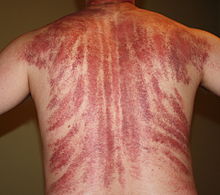Gua Sha
Gua sha(Chinese: 刮痧; pinyin: guā shā), meaning "scraping sha-bruises", is a traditional Chinese medical treatment in which the skin is scraped to produce light bruising. Practitioners believe
gua sha releases unhealthy elements from injured areas and stimulates blood flow and healing.
Gua sha is sometimes referred to as "spooning" or "coining" by English speakers, it has also been given the descriptive French name, tribo-effleurage.[1]
Gua sha was borrowed into Vietnamese from China as cạo gió. This term translates roughly "
to scrape wind", as in Vietnamese culture "catching a cold" or fever is often referred to as trúng gió, "to catch wind". The origin of this term is the Shang Han Lun, a ~220 CE Chinese Medical text on cold induced disease - like most Asian countries China's medical sciences were a profound influence in Vietnam, especially between the 5th and 7th Centuries CE.[2] Cạo gió is an extremely common remedy in Vietnam and for overseas Vietnamese. There are many variants of cạo gió. Some methods use oil balm and a coin to apply pressure to the skin. Others use a boiled egg with a coin inserted in the middle of the yolk. The egg is wrapped in a piece of cloth and rubbed over the forehead (in the case of a fever) and other areas of skin. After the rubbing, when the coin is removed from the egg, it will appear black.[citation needed]
It is also used in Indonesia, and in Java it is known as kerikan (lit., "scraping technique") or kerokan, and it is very widely used, as a form of folk medicine, upon members of individual households.
It was also used in India for treatment of high fever symptoms . People used metal spoon and water for skin lubrication.
Technique
Gua sha involves repeated pressured strokes over lubricated skin with a smooth edge. Skin is typically lubricated with massage oil and commonly a ceramic Chinese soup spoon was used, or a well worn coin, even honed animal bones, water buffalo horn, or jade. A simple metal cap with a rounded edge is commonly used.
In cases of fatigue from heavy work, a piece of ginger root soaked in rice wine is sometimes used to rub down the spine from head to feet.
The smooth edge is placed against the oiled skin surface, pressed down firmly, and then moved down the muscles—hence the term tribo-effleurage (i.e., friction-stroking)—or along the pathway of the acupuncture meridians, along the surface of the skin, with each stroke being about 4–6 inches long.
This causes extravasation of blood from the peripheral capillaries and may result in sub-cutaneous blemishing (ecchymosis), which usually takes 2–4 days to fade. Sha rash does not represent capillary rupture (petechiae) as in bruising, as is evidenced by the immediate fading of the markings to echymosis, and the rapid resolution of sha as compared to bruising.[citation needed]
Practitioners tend to follow the tradition they were taught to obtain sha: typically using either
gua sha or
fire cupping. The techniques are sometimes used together.
Cross-cultural confusion with physical abuse
A slightly different form of
gua sha using the edges of coins rather than porcelain items is practiced as a folk medicine technique. Individuals practice this "coining" amongst their own family members in many Asian cultures, such as Vietnam (where the coin scraping, or "coining" is known as "cạo gió", 'scraping for wind'), in Cambodia, and in their respective immigrant communities abroad. For example, health care practitioners in hospitals in Orange County, California, routinely see evidence of coining among hospitalized Vietnamese patients.
In 1980, it was found that many Vietnamese still distrusted U.S. medical practitioners in part due to fear of being accused of child abuse.[citation needed]
"This practice has been misidentified as child abuse in case reports,"[4] so there is no requirement to contact child protective services if witnessing the results of coining.
Health Safety and Concern
The use of safety standards and proper protocols is still limited and requires further development. The use of hospital standards of sterilization and personal protective equipment is recommended to prevent contamination of infectious pathogens.[5] Although no cases of bloodborne pathogens have been reported, the risk of transmission of blood cells and fluids cannot be ruled out. Protective measurements against infectious agents that are recommended include single use of disposable devices, sterilization of re-used equipment and glove use.[5] Lubricants should be poured out into cups and they are to be disposed after each use.[5] Devices that cannot be adequately sterilized such as horn and bone are not recommended.[5]
There was a case report of acute epiglottitis due to
gua sha treatment on the neck for throat pain.[6] The continuous applied pressure from
gua sha could have damaged the underlying soft tissue, resulting in acute swelling and difficulty breathing
Artwork
The 2001 movie The Treatment (Chinese: 刮痧; pinyin: gua sha) was made in Hong Kong showing
gua sha among other things. The movie starred Tony Leung Ka-Fai, Jiang Wenli, Zhu Xu. It can also be seen in the 1995 Vietnamese movie Cyclo.
Notes
Huard & Wong (1977), p.126. They also cite a French romanization for the same set of two Chinese characters: koua sha.
Jump up ^ Needham, J., Celestial Lancets, Cambridge, UK: Cambridge University.
Jump up ^ One of the first to introduce the technique of gua sha to non-Chinese students in the United States was James Tin Yau So (1911 - ).
Jump up ^ http://childabuse.stanford.edu/faq.html
^ Jump up to: a b c d Nielsen, Arya, Ben Kligler, and Brian S. Koll. "Safety Protocols for Gua Sha (press-stroking) and Baguan (cupping)." Complementary Therapies in Medicine 20.5 (2012): 340-44.
^ Jump up to: a b Tsai, Keng-Kuang, and Chih-Hung Wang. "Acute Epiglottitis following Traditional Chinese Gua Sha Therapy." CMAJ 186.8 (2014)

